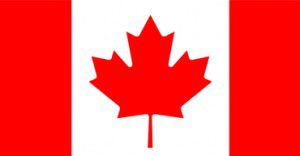
KEY FACTS:
| Capital City: | Ottawa |
| Type of Government: | Constitutional monarchy |
| Head of State: | Queen Elizabeth II |
| Head of Government: | Prime Minister Stephen Harper |
| Official Languages: | English and French |
| Area: | 9,976,140 km 2 |
| Population: | 32.5 million |
| Religion: | Roman Catholic 45%, Protestant and other 55% |
| Currency: | Canadian Dollar ($CAD) |
| Number of Time Zones: | 6 |
| Weights and Measures: | Metric system |
The National Flag of Canada, also known as the Maple Leaf.
GEOGRAPHY
Canada is the world’s second-largest country (9,976,140 km2), surpassed only by the Russian Federation. Canada is made up of ten provinces and three territories. The provinces are: British Columbia, Alberta, Saskatchewan, Manitoba, Ontario, Quebec, New Brunswick, Prince Edward Island, Nova Scotia, the province of Newfoundland and Labrador. The territories are the Yukon, the Northwest Territories (NWT), and Nunavut, Canada’s newest territory.
PEOPLE
Canada’s population is over 30 million with the vast majority (77%) living in cities and towns. The largest cities in Canada are: Toronto (4.44 million), Montréal (3.33 million), Vancouver (1.89 million), Ottawa-Hull, the National Capital Region (1.03 million).
CANADA’S ECONOMY
Canada’s economy is made up of many different industries. There are three main types of industries in Canada: natural resources, manufacturing and services.
- Natural resource industries include forestry, fishing, agriculture, mining and energy. These industries have played an important part in the country’s history and development. Today, the economy of many areas of the country still depends on developing natural resources.
- Manufacturing industries make products to sell in Canada and around the world. Manufactured products include paper, technological equipment, automobiles, food, clothing and many other goods. Our largest international trading partner is the United States.
- Service industries provide thousands of different jobs in areas like transportation, education, health care, construction, banking, communications and government. More than 70 percent of working Canadians now have jobs in service industries.
- Range of options in terms of Programs/ Institutes/ Universities
- Countless Option of Education like Diploma & Bachelor at Undergraduate Level, Masters, PG Diploma and PhD at graduate level.
- Low Tuition Fees
- Part Time Work Opportunities on Campus and Off Campus
- Innumerable Practical Work experience opportunities through its cooperative work term.
- Post Study Work Permit
- Opportunities for PR under different Categories like Canadian experience class, Provincial Nominee program/ Permanent Immigration options for international student who graduate from Canada.
- Great Standard of living
- Scholarship Opportunities
- Qualifications Acknowledged globally
- Affordable Education
- Multicultural Society
- Healthy and Safe Communities
- World-Class Language Education
- Exciting Campus Lifestyle
- Innovative and Abundant Research Opportunities
- Land of Possibilities
- Possibility of Immigration
- Algonquin College
- Assiniboine Community College
- Bow Valley College
- Cambrian College of Applied Arts & Technology
- Camosun College
- Canadore College
- Centennial College of Applied Arts & Technology
- College of New Caledonia
- College of the Rockies
- Columbia College
- Conestoga College
- Confederation College of Applied Arts & Technology
- Douglas College
- Durham College
- Fanshawe College of Applied Arts & Technology
- Fleming College
- George Brown College
- Georgian College of Arts & Technology
- Humber College Institute of Technology & Advanced Learning
- Kwantlen Polytechnic University
- Lakeland College
- Langara College
- Lambton College of Applied Arts & Technology
- LaSalle College
- Loyalist College of Applied Arts & Technology
- Manitoba Institute of Trades & Technology
- Medicine Hat College
- Mohawk College of Applied Arts & Technology
- Niagara College
- North Island College
- Northern Alberta Institute of Technology
- Northern College
- Northern Lights college
- NorQuest College
- Okanagan College
- Parkland College
- Red River College of Applied Arts, Science & Technology
- Saskatchewan Polytechnic
- Sault College
- Selkirk College
- Seneca College of Applied Arts & Technology
- Sheridan College Institute of Technology & Advanced Learning
- St. Clair College of Applied Arts & Technology
- St. Lawrence College
- University of the Fraser Valley
- Vancouver Community College
…and many more
- Vancouver Island University
- Capilano University
- University of Manitoba
- University of Toronto
- Yorkville University
- Lakehead University
- Carletom University
- University of Guelph
- Windsor University
- MC Gill University
- MC Master University
- Fairleigh Dickinson University
- University of British Columbia
- York University
- University of Waterloo
- University of Alberta
- University of Western Ontario
- Ryerson University
- Queen’S University
- University of Calgary
- Concordia University
- Simon Fraser University
- University of Victoria
- Dalhousie University
- University of Saskatchewan
- Brock University
- Memorial University of Newfoundland
- University of Regina
- Macewan University
- Wilfrid Laurier University
- Mount Royal University
- Trent University
- Thompson Rivers University
…and many more
